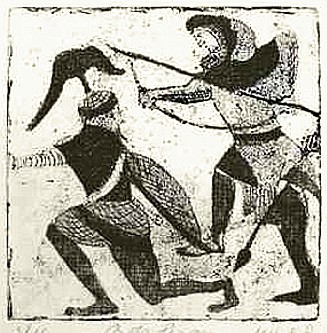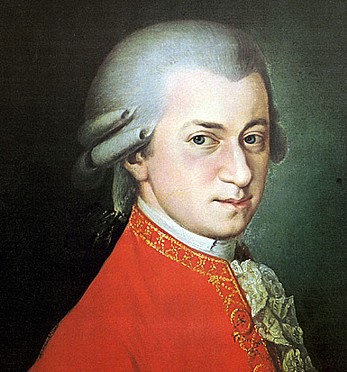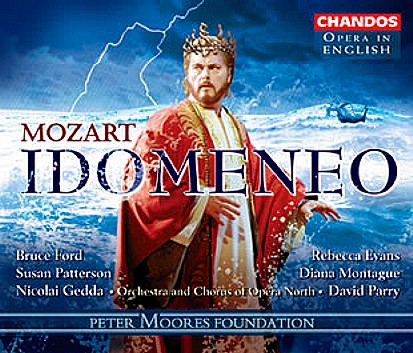Lessico
Idomeneo

Idomeneo combatte contro Enea
In greco Idomeneús.
Re di Creta![]() , figlio
di Deucalione, nipote di Minosse
, figlio
di Deucalione, nipote di Minosse![]() e di
Pasifae
e di
Pasifae![]() , fu uno dei tanti pretendenti
della bella Elena
, fu uno dei tanti pretendenti
della bella Elena![]() e partecipò alla guerra di Troia con ottanta navi (Iliade)
dove fu uno dei guerrieri nascosti nel cavallo di legno. Al ritorno dalla
guerra, durante una violenta tempesta, promise avventatamente a Poseidone, il
dio del mare, che, se si fosse salvato, gli avrebbe sacrificato la prima
persona incontrata non appena sbarcato a Creta.
e partecipò alla guerra di Troia con ottanta navi (Iliade)
dove fu uno dei guerrieri nascosti nel cavallo di legno. Al ritorno dalla
guerra, durante una violenta tempesta, promise avventatamente a Poseidone, il
dio del mare, che, se si fosse salvato, gli avrebbe sacrificato la prima
persona incontrata non appena sbarcato a Creta.
Poiché
per primo gli andò incontro il figlio Merione, Idomeneo, per mantenere la
promessa, lo sacrificò. Gli dei, per punirlo, fecero scoppiare una grande
pestilenza e i Cretesi gli si ribellarono e lo cacciarono. Dapprima Idomeneo
fuggì in Italia, sulla costa salentina, poi si rifugiò a Colofone, dove morì.
Alla storia e al mito del personaggio di Idomeneo è ispirata l'opera Idomeneo,
re di Creta![]() .
musicata da Wolfgang Amadeus Mozart su libretto di Giambattista
Varesco, rappresentata a Monaco di Baviera il 29
gennaio 1781.
.
musicata da Wolfgang Amadeus Mozart su libretto di Giambattista
Varesco, rappresentata a Monaco di Baviera il 29
gennaio 1781.
Idomeneo
Idomeneo è una figura della mitologia greca, figlio di Deucalione e nipote di Minosse; fu re di Creta. Fu uno dei pretendenti della bella Elena e partecipò con ottanta navi alla guerra di Troia, come tutti i suoi altri pretendenti. Nell'Iliade si distinse in numerose imprese, uccidendo Asio (il giovane capo troiano fratello di Niso), Otrioneo, Erimante e Festo. Seppe difendere le navi greche contro gli assalti portati da Deifobo ed Enea. Inoltre fu tra gli eroi che, nascosti nel cavallo di legno, penetrarono nella città; era tra i giudici che attribuirono le armi di Achille a Ulisse meglio conosciuto come Odisseo.
Durante il viaggio di ritorno a casa Idomeneo fu assalito da una burrasca e fece voto, qualora si fosse salvato, di sacrificare a Poseidone la prima persona che avesse incontrato una volta giunto a terra. Idomeneo si salvò, tornò in patria ma la prima persona che vide appena sbarcato fu suo figlio Merione (stesso nome ha inoltre il nipote, che fungerà da scudiero dello zio durante la guerra di Troia). Costretto dunque a mantenere la promessa, sacrificò il figlio a Poseidone; ma gli dei non gradirono quel delitto e scatenarono su Creta una terribile pestilenza, simile a quella che scatenò Apollo per via del conflitto tra Agamennone e Crise. I sudditi allora cacciarono Idomeneo che trovò rifugio nell'antica Calabria, l'attuale penisola salentina, dove sposò Euippa regina dei Messapi. Molti centri del Salento, tra cui Lecce, vantano tra i propri mitici fondatori anche Malennio.
In Greek mythology, Idomeneus was a Cretan warrior, father of Orsilochus, son of Deucalion, grandson of Minos and king of Crete. He led the Cretan armies to the Trojan War and was also one of Helen's suitors. Meriones was his charioteer and brother-in-arms. In Homer's Iliad, he is found among the first rank of the Greek generals, leading his troops and engaging the enemy head-on, and escaping serious injury. Idomeneus was one of Agamemnon's trusted advisors. He was one of the primary defenders when most of the other Danaan heroes were injured, and even fought Hector briefly and repulsed his attack. He was one of the Achaeans to enter the Trojan Horse. Like most of the other leaders of the Greeks, he is alive and well as the story comes to a close.
After the war, his ship hit a horrible storm. Idomeneus promised Poseidon that he would sacrifice the first living thing he saw when he returned home if Poseidon would save his ship and crew. The first living thing was his son, whom Idomeneus duly sacrificed. The gods were angry at his murder of his own son and they sent a plague to Crete. The Cretans sent him into exile in Calabria, Italy.
According
to the hypothetical reading of Achterberg et al. (2004), Idomeneus may be
mentioned on the Phaistos Disk (spelled i-du-ma-na, word B.IX) as the governor
of Mesara. Idomeneo![]() , a
1780 opera seria by Mozart, is based on the story of Idomeneus. In this
version, Poseidon (Neptune in the opera) spares Idomeneo's son on condition
that Idomeneo relinquish his throne to the new generation.
, a
1780 opera seria by Mozart, is based on the story of Idomeneus. In this
version, Poseidon (Neptune in the opera) spares Idomeneo's son on condition
that Idomeneo relinquish his throne to the new generation.

Wolfgang
Amadeus Mozart
Salisburgo 1756 - Vienna 1791
Idomeneo, K 366 (anche noto come Idomeneo re di Creta) è un'opera lirica in lingua italiana di Wolfgang Amadeus Mozart. Il libretto, denominato "Dramma per musica in tre atti" fu scritto da Giambattista Varesco ed è tratto dal libretto di Antoine Danchet per la Tragédie-lyrique Idoménée (Parigi 1712) di André Campra.
Genesi
L'opera fu commissionata a Mozart dal principe elettore della Baviera Carl Theodor nel 1780, per farla rappresentare in forma privata al Residenztheater, il teatro di corte di Monaco di Baviera, nella stagione di carnevale dell'anno successivo. Autore del libretto fu Giambattista Varesco, cappellano di corte dell’arcivescovo di Salisburgo. La composizione fu laboriosa e comportò numerose modifiche a causa della prolissità del libretto, secondo quanto riferì lo stesso Mozart.
Le prove si svolsero tra l'8
novembre 1780 e il 22 gennaio 1781. La prima rappresentazione ebbe luogo il 29
gennaio 1781. Mozart era preoccupato per la resa degli interpreti: temeva in
particolare che il castrato![]() Dal Prato non arrivasse a finire l'aria e definì
Anton Raaf, il tenore che interpreta Idomeneo, "una statua". Fu
invece soddisfatto dell'orchestra di Mannheim, che trovò favolosa,
soprattutto gli archi, e per la quale aveva composto una partitura di
straordinaria ricchezza timbrica, che per un'altra orchestra sarebbe risultata
difficilmente eseguibile.
Dal Prato non arrivasse a finire l'aria e definì
Anton Raaf, il tenore che interpreta Idomeneo, "una statua". Fu
invece soddisfatto dell'orchestra di Mannheim, che trovò favolosa,
soprattutto gli archi, e per la quale aveva composto una partitura di
straordinaria ricchezza timbrica, che per un'altra orchestra sarebbe risultata
difficilmente eseguibile.
La fortuna
Il debutto, il 27 gennaio 1781 fu senza ombre. L'opera fu osannata e fu eseguita per tre sere. Nonostante l'apprezzamento del pubblico della corte di Monaco, negli anni seguenti Idomeneo non conobbe tuttavia che una sola ripresa, quando nel 1786 fu rappresentato a Vienna, in forma privata, nel palazzo del principe Auersperg. Per l’occasione, oltre all'apporto di diversi tagli e alla sostituzione di alcuni numeri della partitura originale con altri composti ex novo, Mozart affidò a un tenore la parte di Idamante. Questo comportò una ridistribuzione vocale negli ensemble dell'opera.
La vera riscoperta di quest'opera avvenne al Festival di Glyndebourne negli anni Ottanta del Novecento. Oggi è frequentemente rappresentata, anche in Italia. Al Teatro alla Scala di Milano fi scelta come opera d'inaugurazione della stagione 2005-2006, diretta da Daniel Harding (7 dicembre 2005).
Scandalo 2006
Molto scalpore ha suscitato la decisione della sovrintendente dalla Deutsche Oper di Berlino Kirsten Harms di annullare la ripresa di un allestimento di Idomeneo per la regia di Hans Neuenfels prevista per il novembre 2006. In questo allestimento vengono mostrate le teste mozzate di Maometto, Gesù, Budda e Nettuno. Questo aveva suscitato preoccupazioni da parte del senatore per l'ordine pubblico e della polizia di Berlino per possibili "azioni violente". Dopo l'intervento del ministro degli interni tedesco Wolfgang Schäuble alla conferenza islamica a Berlino il 27 settembre e altre intermediazioni, il discusso allestimento è andato di nuovo in scena 18 dicembre senza suscitare i temuti disordini.
Caratteri dell'opera

Scritto quando Mozart aveva 25 anni, Idomeneo non è la sua prima opera seria in assoluto, ma la prima nella quale si riscontrano elementi di sperimentazione formale. Con quest'opera egli distrusse dall'interno le convenzioni formali dell'opera metastasiana. Benché l'impianto sia quello tipico dell'opera seria italiana, con la sua tradizionale alternanza di arie e recitativi, molti elementi risultano estranei a quella tradizione e sono più moderni: vengono inseriti cori, danze e brani orchestrali. I cori assumono talvolta un ruolo attivo, come avviene durante la scena dei naufraghi nel primo atto.
Atto I
Dopo la caduta di Troia, Idomeneo, re di Creta, torna in patria dal figlio Idamante, ma la sua flotta in prossimità dell'isola è colta dalla tempesta. Vinto dal timore, fa voto a Nettuno di sacrificargli il primo uomo che incontrerà non appena giunto a terra. La figlia di Agamennone, Elettra, dopo l'uccisione della madre Clitennestra, si è rifugiata a Creta dove si è innamorata di Idamante, il quale ama invece Ilia, figlia di Priamo re di Troia, inviata da Idomeneo a Creta come prigioniera di guerra. Lacerata tra l'amore per un nemico e l'onore di principessa troiana (Padre germani, addio), Ilia respinge Idamante che, informato dell'imminente arrivo del padre, libera i prigionieri troiani e dichiara a Ilia il suo amore.
Elettra, a sua volta, accusa Idamante di proteggere il nemico e di oltraggiare tutta la Grecia. Frattanto giunge Arbace, confidente del re, a portare la falsa notizia che Idomeneo è annegato dopo un naufragio. Idamante allora si ritira in preda al suo dolore, mentre Elettra sfoga la sua disperata gelosia, pensando che ormai Idamante, divenuto il nuovo sovrano, sposerà Ilia. Dalla spiaggia si scorge la flotta di Idomeneo sul mare in burrasca e si odono le grida dell'equipaggio.
Idamante, figlio di Idomeneo, si reca sulla spiaggia, avvisato erroneamente del naufragio del padre. Idamante è il primo uomo che il padre incontra sulla spiaggia. In due non si riconoscono, a causa della lunga assenza di Idomeneo, se non in seguito e Idomeneo inorridisce quando scopre che il giovane incontrato è suo figlio Idamante: preso dal terrore, fugge e gli vieta di seguirlo. Idamante esprime profondo stupore per il comportamento del padre.
Intermezzo
L'intermezzo - che costituisce di fatto il finale dell'atto I - è articolato in due episodi: una marcia dei soldati rientranti in patria e un coro inneggiante a Nettuno (Nettuno s'onori). Nell'intermezzo non canta nessuno dei personaggi principali, solamente il coro, che rende omaggio a Idomeneo e a Nettuno.
Atto II
Idomeneo confessa ad Arbace l'orribile voto che ha fatto per salvarsi la vita. Arbace gli suggerisce, per sottrarsi al suo terribile voto, di inviare Idamante con Elettra ad Argo; ma Idomeneo sospetta che Idamante e Ilia si amino. Elettra manifesta la sua gioia sentendosi ormai prossima a realizzare il suo desiderio più ardente.
Al momento della partenza (Placido è il mar) Idomeneo esorta al figlio di affrettarsi verso Argo, però Nettuno scatena una nuova tempesta e dal mare si leva un orribile mostro. Il re grida il suo sdegno a Nettuno (Ingiusto sei!), gridandogli di prendersela solo con lui, non con tutta Creta. Il popolo, spaventato alla vista del mostro, si rifugia dentro Sidone.
Atto III
Ilia affida ai venti il suo messaggio d'amore per Idamante (Zeffiretti lusinghieri), che le dichiara di essere deciso a cercare la morte combattendo il mostro: Ilia, commossa, gli confida il suo amore. Giungono Idomeneo ed Elettra e, ancora una volta, il re ordina al figlio di lasciare Creta per sottrarsi alla morte (Andrò ramingo e solo).
Arbace annuncia che il popolo vuole che Idomeneo confessi il suo segreto, e lamenta il destino della città (Sventurata Sidone). Il Gran Sacerdote sollecita il re a compiere il voto e chiede il nome della vittima: il re pronuncia il nome del figlio (O voto tremendo). Inizia il rituale del sacrificio, ma giunge Arbace ad annunciare che Idamante ha ucciso il mostro (Stupenda vittoria!). Il principe ora sa tutto e si dichiara pronto a morire, ma, nel momento in cui Idomeneo sta per colpirlo, Ilia si precipita tra le sue braccia e si offre come vittima al posto dell'uomo che ama.
All'improvviso si sente la voce dell'Oracolo di Nettuno: Idomeneo deve rinunciare al trono in favore di Idamante che sposerà Ilia e poi regnerà in luogo del padre. Elettra, furente, impreca (D'Oreste, d'Aiace) e poi fugge. Idamante viene incoronato tra cori e danze (Scenda amor, scenda Imeneo).

Idomeneo re di Creta ossia Ilia e Idamante (Italian: Idomeneo, King of Crete, or, Ilia and Idamante; usually referred to simply as Idomeneo, K. 366) is an Italian opera by Wolfgang Amadeus Mozart. The libretto was adapted by Giambattista Varesco from a French text by Antoine Danchet, which had been set to music by André Campra as Idoménée in 1712. Mozart and Varesco were commissioned in 1780 by Karl Theodor, Elector of Bavaria for a court carnival. He probably chose the subject, though it might have been Mozart. The libretto clearly draws its inspiration from Metastasio and its overall layout, not to mention the type of character development which Metastasio had developed and mostly from the highly poetic language used in the various numbers and the secco and stromentato recitatives. The style of the choruses, marches, and ballets was very French, and the shipwreck scene towards the end of Act I is almost identical to the structure and dramatic working-out of a similar scene in Gluck's Iphigénie en Tauride. The sacrifice and oracle scenes are similar to Gluck's Iphigénie en Aulide and Alceste. Kurt Kramer has suggested that Varesco was familiar with Calzabigi and therefore the work of Gluck, especially the latter's Alceste; much of what we see in Varesco's most dramatic passages is the latest French style, mediated by Calzabigi. It is thanks to Mozart, though, that this mixture of French styles (apart from a few choruses) moves away from Gluck and France and returns to its more Italian (opera seria) roots; the singers were all trained in the classical Italian style, after all, and the recitatives are all classically Italian.
It was first performed at the Cuvilliés Theatre of the Residenz in Munich on January 29, 1781. Written when the composer was 24, Idomeneo was Mozart's first mature opera seria, and with it he demonstrated his mastery of orchestral color, accompanied recitatives, and melodic line. In certain respects (e.g., the choirs), however, this opera is still an experimental drama, resulting more in a sequence of sets than in a well developed plot. Mozart also had to fight with the mediocre author of the libretto, the court chaplain Varesco, making large cuts and changes, even down to specific words and vowels disliked by the singers (too many "i"s in "rinvigorir").
Idomeneo was performed three times at Munich, and later in 1781 Mozart considered revising it to harmonise it with Gluck's style. This would have meant a bass Idomeneus and a tenor Idamantes, but nothing came of it. A concert performance was given in 1786 at the Auersperg palace in Vienna, and as well as changing Idamantes from a castrato to a tenor, Mozart wrote some new music and cut out other parts.
In the late 1920s, Richard Strauss began working on a revised version of Idomeneo. This version premiered in 1930 and boasted a completely different libretto by Lothar Wallerstein. Strauss cut much of Mozart's score replacing it with some his own compositions. He also rearranged the order of the musical numbers and changed name of the character of princess Electra to the priestess Ismene. Critics have noted that Strauss' additions to the opera contain an odd blend of the classical style of composition and Strauss' own characteristic sound. In 1984, the Mostly Mozart Festival presented Strauss' version of Mozart's Idomeneo with Jerry Hadley in the title role, Delores Ziegler as Idamantes, and Alessandra Marc as Ismene. Today Idomeneo is part of the standard operatic repertoire. There are several recordings of it (see below), and it is regularly performed.
Act 1
Island of Crete, shortly after the Trojan War. Ilia, daughter of the defeated Trojan King Priam and taken to Crete, loves Prince Idamante, son of Idomeneo, but she hesitates to acknowledge her love. Idamante frees the Trojan prisoners in a gesture of good will. He tells Ilia, who is rejecting his love, that it is not his fault that their fathers were enemies. Trojans and Cretans together welcome the return of peace, but Electra, daughter of the Greek King Agamemnon and jealous of Ilia, does not approve of Idamante's clemency toward the enemy prisoners. Arbace, the king's confidant, brings news that Idomeneo has been lost at sea while returning to Crete from Troy. Electra, fearing that Ilia, a Trojan, soon will be Queen of Crete, feels the furies of Hades tormenting her.
Idomeneo is not lost at sea, but instead is saved by Neptune (god of the sea) and is washed up on a Cretan beach. There he recalls the vow he made to Neptune: to sacrifice, if he should arrive safely to land, the first living creature he should meet. Idamante approaches him, but because the two have not seen each other for a long time, recognition is difficult. When Idomeneo finally realizes the youth he must sacrifice for the sake of his vow is his own child, he orders Idamante never to seek him out again. Grief-stricken by his father's rejection, Idamante runs off. Cretan troops disembarking from Idomeneo's ship are met by their wives, and all praise Neptune.
Act 2
At the king's palace, Idomeneo seeks counsel from Arbace, who says another victim could be sacrificed if Idamante were sent into exile. Idomeneo orders his son to escort Electra to her home, Argos. Idomeneo's kind words to Ilia move her to declare that since she has lost everything, he will be her father and Crete her country. As she leaves, Idomeneo realizes that sending Idamante into exile has cost Ilia her happiness as well as his own. Electra welcomes the idea of going to Argos with Idamante.
At the port of Sidon, Idomeneo bids his son farewell and urges him to learn the art of ruling while he is away. Before the ship can sail, however, a storm breaks out, and a sea serpent appears. Recognizing it as a messenger from Neptune, the king offers himself as atonement for having violated his vow to the god.
Act 3
In the royal garden, Ilia asks the breezes to carry her love to Idamante, who appears, explaining that he must go to fight the serpent. When he says he may as well die as suffer the torments of his rejected love, Ilia confesses her love. They are surprised by Electra and Idomeneo. When Idamante asks his father why he sends him away, Idomeneo can only reply that the youth must leave. Ilia asks for consolation from Electra, who is preoccupied with revenge. Arbace comes with news that the people, led by the High Priest of Neptune, are clamoring for Idomeneo. The High Priest tells the king of the destruction caused by Neptune's monster, urging Idomeneo to reveal the name of the person whose sacrifice is demanded by the god. When the king confesses that his own son is the victim, the populace is horrified.
Outside the temple, the king and High Priest join with Neptune's priests in prayer that the god may be appeased. Arbace brings news that Idamante has killed the monster. As Idomeneo fears new reprisals from Neptune, Idamante enters in sacrificial robes, saying he understands his father's torment and is ready to die. After an agonizing farewell, Idomeneo is about to sacrifice his son when Ilia intervenes, offering her own life instead. The Voice of Neptune is heard. Idomeneo must yield the throne to Ilia and Idamante. Everyone is relieved except Electra, who longs for her own death. Idomeneo presents Idamante and his bride as the new rulers. The people call upon the god of love and marriage to bless the royal pair and bring peace.